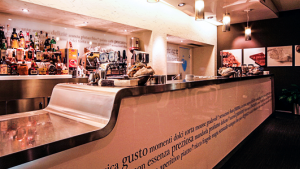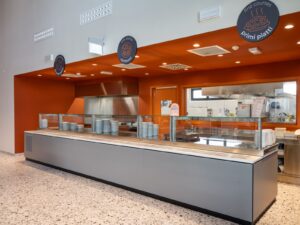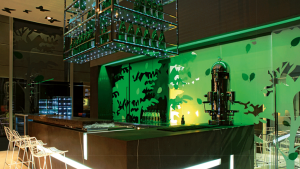The task of an interior designer is precisely to find the ideal Cafeteria furniture style, one that combines functionality and aesthetics.
How to Choose the Perfect Style
Café and bar often seem synonymous and are frequently confused. In reality, the two types of establishments have very different origins historically and, even today, are distinguished by their offerings and style.

The bar is a more versatile place due to its varied offerings of breakfasts, aperitifs, and lunches, catering to a broader and more diverse clientele.
On the other hand, the café is a more niche gathering place, where people meet to sip and enjoy various blends of coffee, tea, hot chocolate, and warm beverages, often accompanied by pastries, slices of cakes, and tarts.
Even in terms of interior design, different styles are typically chosen; while a modern style is preferred in a bar, a café often leans toward a classic or vintage décor.
Cafeteria furniture: Identifying the Right Spaces
A café has always been a successful business, especially when opened in a strategic location, such as a busy street in the historic center or near offices, agencies, and shops.
Offering a good selection of products is very important, as is knowing how to recommend pairings with certain coffees or hot drinks, but above all, it is essential to entice people to come inside.
The role of an interior designer is to find the ideal Cafeteria furniture style that unites functionality and aesthetics.
First and foremost, it’s necessary to identify the spaces dedicated to customers and staff, ensuring they are welcoming, hospitable, and, importantly, practical:
- Space dedicated to the counter
- Space for placing the cash register (preferably separate from the counter)
- Area designated for restrooms (separated for staff and customers)
- A room for table service with product display cases.
If space allows, consider a small room or an area dedicated to children, adding extra value for young families with children.
The counter is the centerpiece due to its dual function: it must be well-equipped, spacious, and capable of allowing staff to move efficiently and quickly; at the same time, it should be eye-catching and attract the target clientele. Additionally, the counter is often used by customers for quicker consumption or to engage in conversation with the staff.
Behind the counter, there should always be the coffee machine and all the equipment needed to prepare drinks, such as tea, infusions, and fresh juices. If the offering includes artisanal pairings, it is beneficial to integrate a display case into the counter to showcase the most attractive and delicious products.
The cash register is often placed next to the counter, especially in bars. However, in a café, if space permits, it is more appropriate and elegant to place it at the entrance, clearly separating the two areas but maintaining a consistent design with the counter.
The restrooms for staff and customers must be separated by law, and it is also advisable to locate them in different areas for greater discretion and privacy.
Finally, the main customer area should be organized with comfortable tables and seating, and if possible, create a private area with poufs and sofas.
Table arrangements are crucial and should be designed ad hoc to ensure adequate privacy, while also being mindful not to create excessive spacing.
Cafeteria furniture: Customize Your Space with Taste and Charm
To find the perfect furnishings for your café, you can opt for trendy solutions or choose a more retro style, which is always suitable for this type of establishment.
It’s always good to add elements that reflect your personality, but care must be taken to integrate them in a coherent, harmonious, and elegant way.
The preferred décor for a café is usually chic and refined, but more original and diverse style options can also be found.
For example, a retro or vintage style fits well with the type of offerings and target clientele. This creates a journey through time, evoking a nostalgic past while maintaining ties to the present in perfect harmony. Genuine antique furniture and objects, such as cabinets, upholstered chairs, sofas, small tables, typewriters, and vintage-style wall decorations can be added.
Another popular style is shabby chic, which appreciates everything worn or distressed—not necessarily antique—and incorporates it into a chic and refined context. However, care must be taken not to make the space appear neglected.
Scandinavian style, with its simple and clean lines, the predominance of light colors, and warm, soft fabrics, is also very trendy.
Once you have chosen the style that best reflects you and matches your personality, consult with professionals and interior designers to find the perfect Cafeteria furniture solution that combines functionality and aesthetics seamlessly. Turn to the Cook-In team, a company specializing in professional restauration furnishings and equipment for over 30 years.



